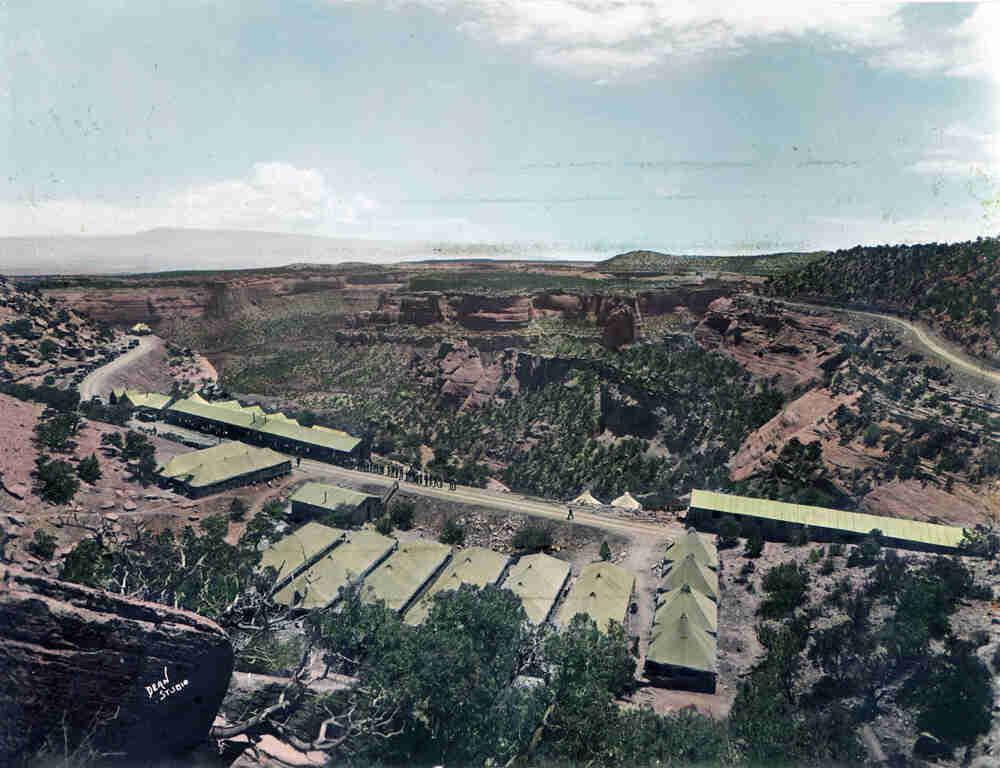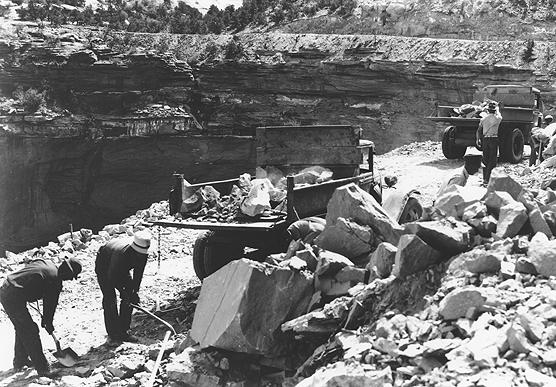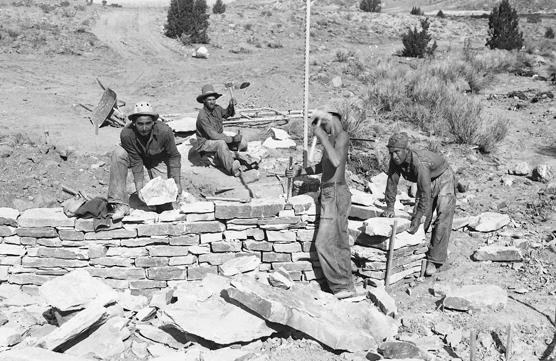Rim Rock Drive
Full Article
Built primarily by New Deal work programs in the 1930s, Rim Rock Drive is a twenty-three-mile scenic road through Colorado National Monument. Connecting Fruita and Grand Junction, the road increased tourism to the monument by allowing travelers to drive through and continue on their journey. The road’s construction and landscaping are prime examples of the National Park Service’s naturalistic or rustic style, which emphasized native materials and harmony with the natural environment.
Early Efforts
In 1911, thanks to the efforts of John Otto, President William Howard Taft established Colorado National Monument west of Grand Junction. Over the next decade, Otto directed the construction of the Serpents Trail, the first road in the monument. Also called the Serpentine Trail or the Trail of the Serpent, the road was designed to provide automobile access to the monument from Grand Junction and to shorten the drive to Grand Junction for farmers and ranchers in Glade Park, a community just on the other side of the monument. Funded by a coalition of Grand Junction investors, Glade Park residents, and Mesa County, the Serpents Trail was completed in 1921. With fifty-two switchbacks in only 7.5 miles, it was considered an extremely dangerous drive.
Otto dreamed of extending the Serpents Trail to connect Grand Junction and Fruita through Colorado National Monument, but his idea never went forward before he left Colorado in the early 1930s. When Colorado National Monument received a $75,000 road appropriation in 1931, however, the National Park Service and local boosters started to plan their own road through the monument. The Grand Junction Chamber of Commerce pushed for a route that would show off the monument’s most scenic features to travelers in automobiles. The route would connect Grand Junction to Fruita via the monument, allowing travelers to exit the highway, drive through the monument, and continue on their way.
These goals made the road more expensive than it would have been otherwise, but the National Park Service agreed and the Chamber of Commerce contributed money and workers to support the project. The local community also helped acquire a few parcels of land necessary to allow the road to take the desired route through the monument.
Construction on Rim Rock Drive began in November 1931 with a workforce of about fifty men, who had been unemployed, from Mesa County. Work started on the west (Fruita) side of the monument, with the goal of opening Monument Canyon to automobile tourists as soon as possible. A mix of local and federal funds kept the project going for the next eighteen months.
New Deal Construction
The next phase of construction started in 1933, with the advent of the New Deal. The Civilian Conservation Corps (CCC) did much of the work of carving and grading Rim Rock Drive through Colorado National Monument. The first CCC camp in the monument was approved in April 1933, with workers arriving in May and June. Other workers came from the Works Progress Administration, Public Works Administration, Emergency Relief Administration, and National Park Service.
The road is notable for its engineering. For much of its length, the road was built through solid rock using manual labor. Men drilled, blasted, and sledgehammered rocks that had to be removed by hand or carted away by horses. The road includes three tunnels to allow it to climb steep canyon walls to the top of the monument as well as more than 200 culverts to help it drain and prevent erosion.
Between July 1932 and July 1937, more than $500,000 was appropriated for the construction of Rim Rock Drive. The funding came from a variety of federal agencies and local sources, including the Civil Works Administration, Emergency Conservation Works, Federal Emergency Relief Administration, National Park Service, and Grand Junction Chamber of Commerce. By July 1937, twenty of the road’s eventual twenty-three miles were completed.
Construction of the road eventually increased tourism in the region, but it also had a more immediate and obvious effect on Mesa County’s economy. The project employed more than 800 men at its height and boosted local companies that sold construction materials and camp supplies. Construction in Colorado National Monument came to a halt in 1942, when able-bodied men were needed for more pressing wartime work.
Recent History
 As originally constructed, Rim Rock Drive was graded gravel. Plans to pave it were proposed as early as 1937 but did not proceed until after World War II; work on the road resumed in the late 1940s. The sections closer to Fruita were paved first, and the final eastern sections near Grand Junction paved by 1951. In 1950 the Serpents Trail was closed to vehicle traffic and later converted into a hiking trail. With the completion of the new road, annual visitation to Colorado National Monument rocketed from 20,000 as a prewar peak to more than 100,000 in 1950.
As originally constructed, Rim Rock Drive was graded gravel. Plans to pave it were proposed as early as 1937 but did not proceed until after World War II; work on the road resumed in the late 1940s. The sections closer to Fruita were paved first, and the final eastern sections near Grand Junction paved by 1951. In 1950 the Serpents Trail was closed to vehicle traffic and later converted into a hiking trail. With the completion of the new road, annual visitation to Colorado National Monument rocketed from 20,000 as a prewar peak to more than 100,000 in 1950.
In the 1950s and 1960s, the monument faced the problem of increasing commercial traffic on Rim Rock Drive to and from Glade Park’s mines and ranches. Local property owners felt they had a right to use the road without paying fees, whereas the National Park Service was trying to impose stricter regulations on how the road was used. This conflict led to a series of meetings and plans in the 1970s and eventually to a lawsuit involving the National Park Service, Mesa County, and a local property owner, John Wilkenson, in the 1980s. The suit questioned the National Park Service’s authority to regulate the road and in 1986 was decided in favor of the plaintiff, with the court declaring that a public right of way existed on Rim Rock Drive from the east (Grand Junction) entrance to the Glade Park turnoff.
In 1993 Rim Rock Drive was listed on the National Register of Historic Places. The monument now receives more than 400,000 visitors per year, most of them traveling on the scenic drive.













